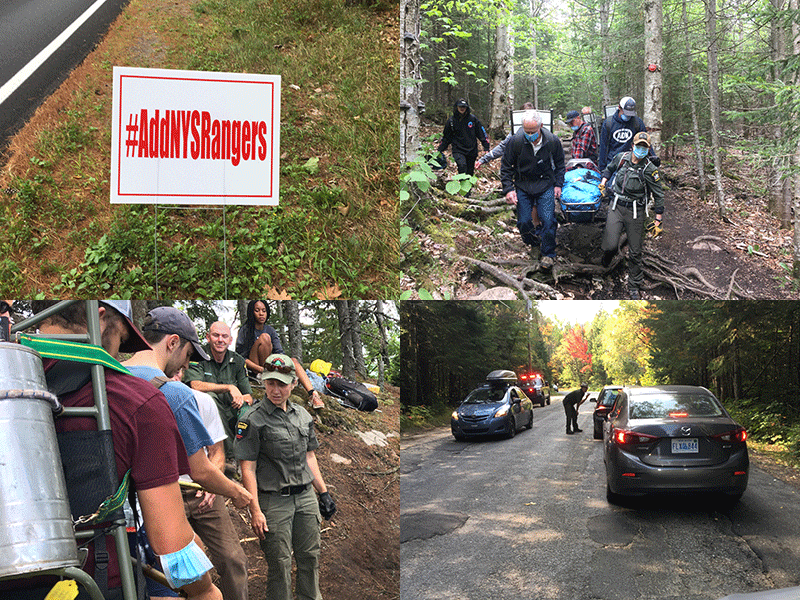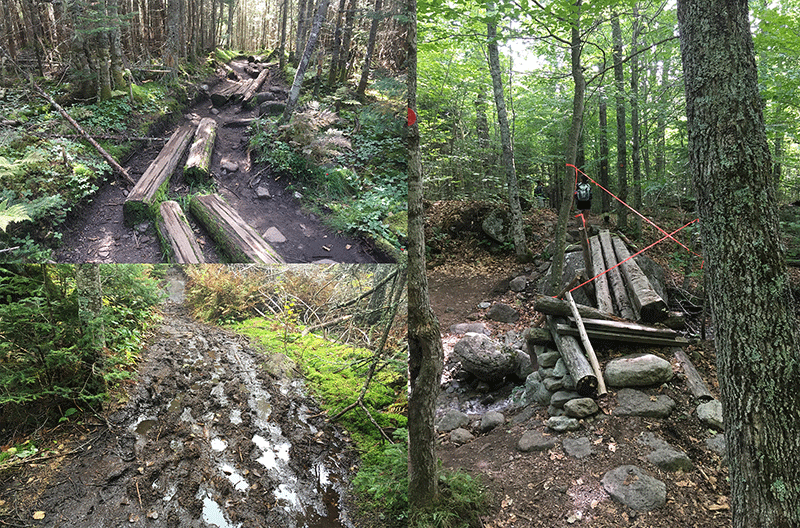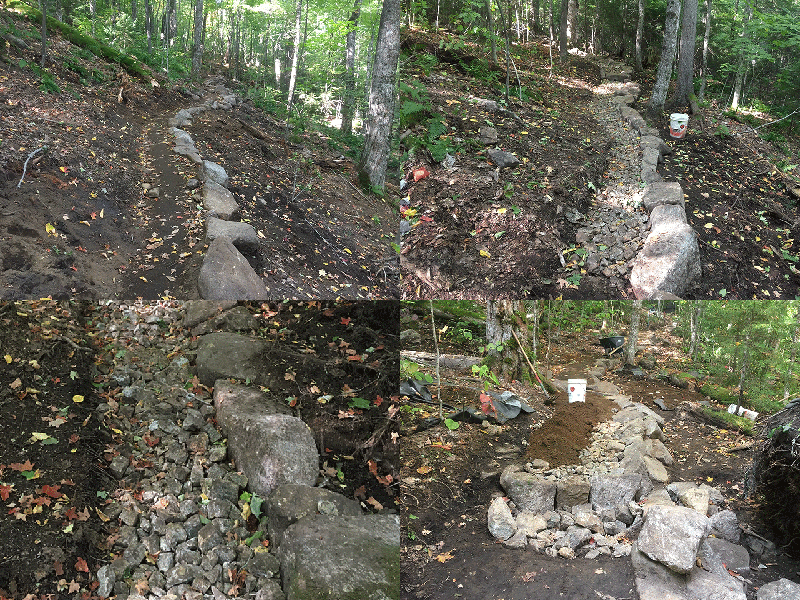New High Peaks Advisory Group report calls for broad, long-term reforms of Forest Preserve management.
The eagerly awaited final report of the High Peaks Strategic Planning Advisory Group (HPAG) is out. It was worth the wait. The report is ambitious and thorough and comes at a point in time that could potentially mark a new beginning, where we’ll start to see a leavening in the overall management of the High Peaks Wilderness in particular and the Forest Preserve in general. Or, this report could be filed away to rust, lost to time. I hope that this report sees serious follow-up and implementation.
Bringing serious reforms to the management of the High Peaks Wilderness, and the Forest Preserve, is no easy task, but the HPAG report is the most serious blueprint we’ve seen since the days of the Pomeroy Committee and Temporary Study Commission on the Future of the Adirondacks the 1950s and 1960s.
The HPAG report is a mixed bag to read. It importantly amplifies ways to improve the High Peaks Wilderness Area management, but fails to fully diagnose the key challenges facing the High Peaks, and soft sells the impediments to meeting these challenges. The report is keenly aspirational, telling us that the High Peaks Wilderness is a “world-class Wilderness destination” that requires a “world-class visitor management system.”
The report is meant to be a catalyzing document that will lead to changes and reforms in High Peaks management through a new permanent advisory body and through a number of different studies that gather data on various management challenges. This data will help the advisory committee work with state agencies to implement reforms. The report is based on the belief that significant new financial resources and staffing are needed, and will soon be made available, for long-term investments in the High Peaks Wilderness and associated Wilderness areas. The Cuomo Administration has mystifyingly refused to invest in the High Peaks Wilderness in the last 10 years. An early indication of what kind of buy-in this report will get from state agencies is funding in the new state budget passed at the end of this month and forming a long-term advisory body.
The report is filled with jargon. In some places, the text is impenetrable. In many places, the report fails to provide basic explanatory text to set the context for its recommendations. It does a poor job of documenting the High Peaks Wilderness problems and explaining how its recommended actions will meet these challenges. The report is aimed at a population who is well-versed in the problems and challenges facing the High Peaks and who already think about ways to improve the region’s stewardship and management. The strength of the report is the sheer quantity and depth of its recommendations, of which I count a total of 150, that call for action.
There’s a lot in the report, far too much to distill in one article. This piece is the first of seven articles that will examine the HPAG report’s ideas, which are listed below, both those newly hatched by the report and those that have been around for a while, which the report kindly showcased. The purpose of this article, and those below, is to not just distill the report’s recommendations but also to try and promote the full suite of issues that are vital for improving the management of High Peaks Wilderness. At this point in the history of the Adirondack Park, it would be a crime for these ideas to be ignored.
What’s most interesting in this report is that it recommends, ever so politely, to scrap the existing management framework of the DEC and APA in favor of a new bureau or division or unit that will somehow shake free of the bureaucratic shackles of DEC-APA to foster much better stewardship and management of the High Peaks. That is one way to do it. Another would be to fix the APA and DEC. The report focuses on the safer route of creating something new rather than trying to fix what’s broken.
The report makes recommendations for action in six areas: 1) Impacts to Wilderness and Ecology; 2) Visitor Experience; 3) High Peaks Wilderness Trails; 4) Public Safety, Transportation, and Traffic Safety; 5) Community – “Hamlets as Hubs”; and 6) Stabilizing Financial Support. The next six pieces will look at each of these areas. This piece focuses on the “long-term overall recommendations” and “guiding principles” of the HPAG report.
The Executive Summary highlights six “long-term overall recommendations”:
- the establishment of an Adirondack Advisory Group, a new entity made up of members representing diverse interests to guide development of the strategic plan and the ongoing adaptive management that supports it;
- the use of adaptive management and the adoption of the National Parks Service’s Visitor Use Management Framework (VUMF) as the guiding tool;
- the establishment of an outdoor recreation unit within DEC;
- real time data collection and information dissemination;
- further ongoing study and planning for parking and shuttle management: and
- an “all in” approach to provide needed resources and funding for these efforts.
These are all admirable goals that if realized will help to improve the overall management of the High Peaks Wilderness. However, I’ve always thought that a Wilderness Management Bureau within the DEC Division of Lands and Forests may create a better focus for Wilderness management than one that focuses purely on outdoor recreation.
The HPAG report lists eight “guiding principles” that shaped its recommendations and that the HPAG believes should guide future management actions. The guiding principles profess an “unwavering commitment” to Article 14 of the state constitution, which is currently embattled, and the Adirondack Park State Land Master Plan. One potential problem is that the report justifies a new planning and decision-making process for the High Peaks Wilderness that will remain outside the legal framework of the Adirondack Park State Land Master Plan, a document designed to hold state agencies publicly accountable for its management of public lands.
Guiding Principle 1 is “Protection of the Wilderness” and Principle 2 is “Public Safety.” These two principles, we are told, “are inviolate guiding principles for the management of the High Peaks region.” Bravo!
Guiding Principle 3 is “A commitment to green infrastructure, transportation, and practices consistent with New York State’s Climate Leadership and Community Protection Act [CLCPA] and related climate initiatives.” This is an important statement because both the Department of Environmental Conservation (DEC) and Adirondack Park Agency (APA), the key Forest Preserve management agencies in the Adirondacks, routinely blow off climate change mitigation. The DEC recently gave us 10 pages in the new draft Debar Mountain Complex Unit Management Plan of all the reasons it cannot undertake climate change mitigation in Forest Preserve management. For its part, the APA gives us similar rhetoric about why its approvals of subdivisions in intact forests that create massive carbon debts are somehow outside the reach of CLCPA.
Guiding Principle 4 is “A commitment to social justice, equity, diversity, and inclusion in all aspects of management in the High Peaks region, from education to policies, visitor programs, hiring, and staffing.” This is an important statement, but the report hardly includes a blueprint for achieving this but points to other efforts that may pave the way.
Guiding Principle 5 is “A commitment to bring proven expertise, science, and best management practices into the process. These best management practices need to address the entire spectrum of management actions that will be necessary to positively meet this crisis moment and reshape visitor services and natural resource protection in a new age of unprecedented use.” This is important. Two recent resignations from the APA Board, by Richard Booth and Chad Dawson, both criticized the APA and DEC for their failures to use science in Forest Preserve management decision making. DEC Commissioner Basil Seggos, like Governor Cuomo, gives lip service to the importance of science in making public policy, but then uses politics or personal goals or personal biases to make decisions. The majority of current APA Board members are openly dismissive about the need to use science in decision-making as is the APA’s senior staff. I have not seen a “commitment to bring proven expertise, science, and best management practices into the process” by the APA and DEC in years.
Guiding Principle 6 says “Use the best methods for assessment of conditions and development of action plans. At the cornerstone is elevating the use of limits of acceptable change approaches, which requires managers to define desired resource conditions and take actions to maintain or achieve those conditions. This requires making a commitment to establish benchmarks through empirical research and continued monitoring and response.” Note my earlier comments about the report’s use of jargon.
Given that it’s been nearly 50 years since adoption of the Adirondack Park State Land Master Plan, which called for development of Unit Management Plans for all Forest Preserve units, and we still do not have UMPs for hundreds of thousands of acres of the Forest Preserve, call me skeptical about the ability of the DEC-APA to “define resource conditions” or elevate “the use of limits of acceptable change approaches” or benchmark or monitor or undertake empirical research. It’s simply not in the bureaucratic-political DNA of those agencies. Nevertheless, other public land management agencies do this work, and have done so for years, such as the National Park Service, so it’s possible, and the report stakes its future success on organizing and implementing this new paradigm shift at the APA-DEC.
Guiding Principle 7 says “To provide necessary funding, support, and human resources for the DEC, Adirondack Park Agency (APA), Department of Transportation (DOT), and other state agencies and local municipalities, as well as volunteer and non-profit partners, to adequately meet the needs associated with managing a world-class Wilderness destination. This principle includes Forest Rangers, Assistant Forest Rangers, Operations staff, Planners, Foresters, Trailhead and Summit and Natural Resource Stewards, outdoor recreation planners and managers, and other staff.” Forgive me here for wincing, but anyone who has tuned into Legislative Budget Hearings in recent years has heard legislators ask DEC Commissioner Basil Seggos if he has the staff to meet his mandates. He dutifully replies yes, all is well, which is met with laughter and skepticism. Seggos and Cuomo tell us that less is more, but the reality that we all see on the ground is that less is less. The next few weeks will tell us a lot as the new budget comes together. I’ve been lobbying the legislature, along with many others, to boost funds for Forest Preserve Stewardship in the new state budget, and there is support, but the Governor’s Office has to meet this moment and prioritize funding and investment in the High Peaks Wilderness and the Forest Preserve to make this happen.

More staffing is needed to help manage the High Peaks Wilderness, not just more Rangers, but more Wilderness managers and backcountry stewards and educators.
HPAG lists Guiding Principle 8 as “A commitment to an open, transparent, and ongoing process that involves a broad range of stakeholders and the public. The future of these recommendations must be built upon public engagement.” This principle, I hope, was written in recognition of one of HPAG’s major failings. HPAG meetings for the last year were closed to the public and their posted summaries of these meetings were exceedingly poor. HPAG was a grand missed opportunity for public education. I had one Cuomo staffer, who recently left the administration, tell me when I complained about these closed sessions that I was misinformed and that these meetings were open to the public. This level of disengagement by Cuomo’s top environmental staff should worry us all about the commitment, and ability, of the Cuomo Administration to pick up the challenge laid down by this report.
The HPAG report starts with a series of overall recommendations that accompany its guiding principles.
The first overall recommendation says “Future strategic planning and design of a visitor use management structure for the High Peaks region should be undertaken in a manner that can be applied to other regions in the Adirondack Park and other regions of New York State that are experiencing high use and addressing similar issues.” Hear, hear. It would be something to see a visitor use management program established for the entire Forest Preserve across the Adirondacks and Catskills.
The second states “The State should convene and fund an Adirondack Advisory Group (AAG) as an ongoing group of diverse stakeholders and wilderness management experts to take the HPAG recommendations forward and guide the development of a strategic plan as well as act as an ongoing resource for visitor management.” This envisions the development of an overriding plan for all of the associated Wilderness areas around the High Peaks and should include planning efforts for Mountain Hoevenberg by the Olympic Development Authority (ORDA) and the Department of Transportation for the Route 73 travel corridor. This plan will be developed by a body of stakeholders outside APA-DEC, but that works with APA-DEC. In this way the HPAG hopes to build public accountability into the process along with empowering a vanguard group to make things happen. Hear, hear.
The third states “The State should implement a world-class visitor management system for the High Peaks Wilderness, and ultimately the Park as a whole, using an adaptive management framework. The HPAG recommends adoption of the National Park Service’s Visitor Use Management Framework (VUMF) as the adaptive management tool.” This in an important focus in the report. The DEC-APA have struggled to develop their own management and monitoring frameworks. Past UMPs talked about how the DEC was blending together different “carrying capacity” programs to create its own monitoring program, but these programs never came together. If VUMF can be successfully utilized in the High Peaks Wilderness that will mark a major step forward.
HPAG calls for VUMF to be managed by a new entity with the DEC. “While recreation is a component of DEC’s Lands and Forest Division, a renewed focus on outdoor recreation management must be accompanied by the hiring of trained outdoor recreation professionals familiar with these unique challenges and opportunities. This formal role must encompass and coordinate natural resource management, visitor experience, trail/facility construction, operation and maintenance, and education.” That’s a big list, beyond the scope of the current DEC Division of Lands and Forests. There certainly needs to be a renewed focus on Forest Preserve management by the DEC, with attendant staffing, the question is how this group is organized. This, of course, is a key reform.
The report states “World-class adaptive management can only be achieved if it actively involves all stakeholders in a coordinated effort at the data level, process level, and policy level.” This new management entity is expected to partner in different ways with a variety of stakeholders. Hear, hear.
The fourth states “Data collection, information dissemination, and real-time conditions at parking areas, trails, and other amenities should be integrated into a consistent information framework, including an online app, web and social media resources, kiosks, and message boards. Ultimately, data should be available in a Geographic Information System (GIS).” That’s a tall feat to pull off, but this is something done regularly in national parks. This should be attainable in the Adirondack Park.
The fifth says “An ‘all-in’ commitment of resources and funds by the State and partners must be made to inventory, improve, and maintain the trails in the High Peaks region and recognize them as the vital infrastructure they are.” There are roughly 300 miles of trails in the High Peaks complex, 200 miles of formal trails and 100 miles of herd paths to trailless peaks. The current ad hoc system has produced band-aids like the wooden staircase on Mount Colden as well as the new sustainable trails on Mount Van Hoevenberg and Cascade Mountain. An effort to rebuild this network into a formal trail system would be the largest Forest Preserve management program ever undertaken. A recommendation for an inventory of 80 miles of high priority trails in the summer of 2020 in the HPAG interim report was never undertaken, which shows how daunting a job this is.
The sixth major recommendation says “The Volpe Shuttle Feasibility Study commissioned by DEC should be the basis for in-depth planning using the Complex Planning mechanisms recommended above. Parking design and transportation are important tools for managing capacity in general and at specific sites. DEC must collect data and use that data to adjust management actions for each site. The management goal is to meet the demand for parking, while balancing need for the protection of the resource. This process will have to be ongoing.” So, beyond the jargon and policy-speak, the idea is to improve the ways that visitors to access High Peaks trails, which involves parking and shuttles. These are complicated issues that require good information to help develop solutions. The HPAG report weirdly never mentions the South Meadows Road or the parking problems on the Loj road, but tackling those thorny issues should clearly be part of the mix.
In the weeks after the High Peaks Advisory Group was named in late December 2019, the Department of Environmental Conservation announced that the public was invited to share comments. Protect the Adirondacks submitted a 20-page letter with 33 recommendations to the group. There’s a lot of overlap between what we recommended and what HPAG has published.
The next articles will dig deeper into the specific recommendations, section by section. We hope that this plan gets the platform it merits, that its ideas break into the public mind, and that its ideas are met with open and honest evaluation and consideration by the state agencies.








